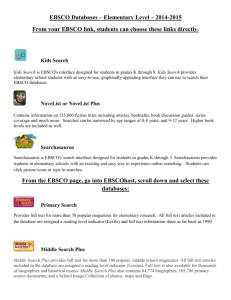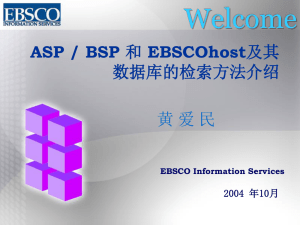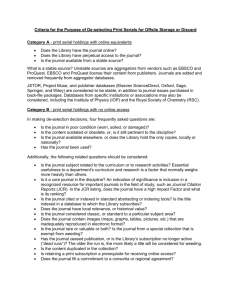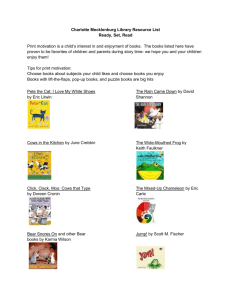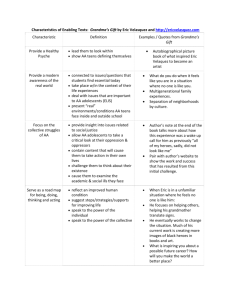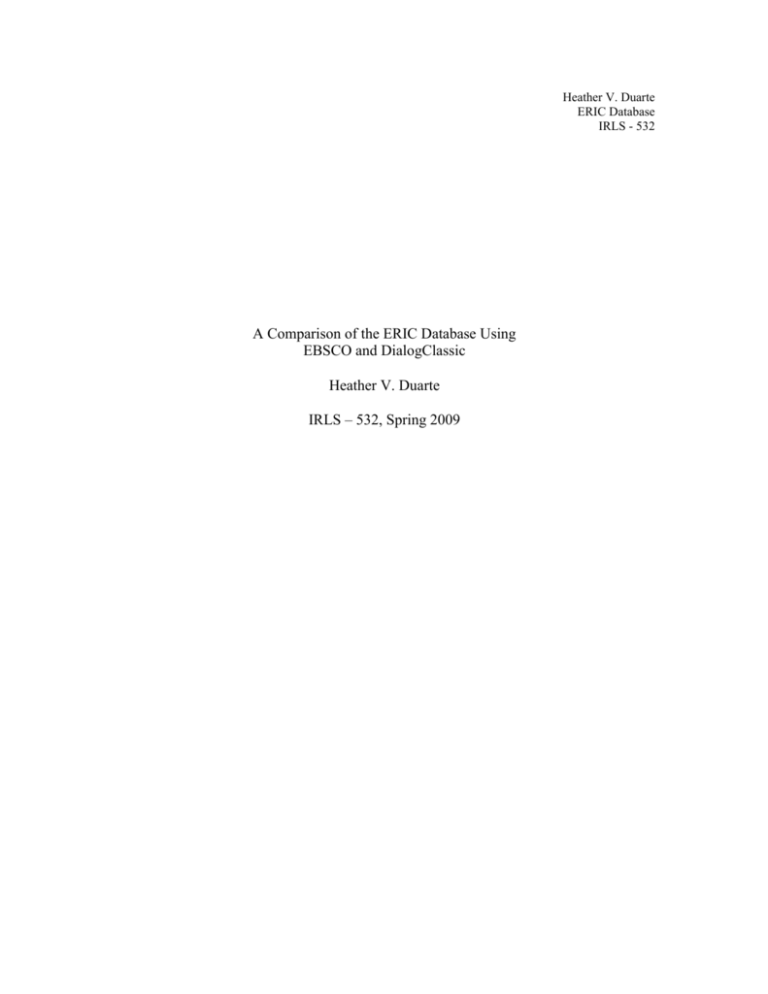
Heather V. Duarte
ERIC Database
IRLS - 532
A Comparison of the ERIC Database Using
EBSCO and DialogClassic
Heather V. Duarte
IRLS – 532, Spring 2009
Heather V. Duarte
ERIC Database
IRLS - 532
Introduction
Are all databases made equally? The obvious answer to this question is no. Comparing
different databases could be the equivalent of comparing apples to oranges. There is,
however, a comparison that can be made. Many databases are offered by various vendors.
Each of these vendors has a different search engine and allow for different ways to search
the database.
The ERIC database is offered by two well known vendors, EBSCO and DialogClassic.
The following is not an attempt to compare the usability of these vendor's search engines,
but a direct comparison of the ERIC database and search functions offered by each of
these vendors.
Will the database be equal for both EBSCO and DialogClassic? Or will they look like
two entirely different databases?
Database Content
The ERIC database is remarkably similar from both the EBSCO and DialogClassic
vendors. In fact, they are almost entirely identical in content.
ERIC stands for Education Resource Information center. The primary function of this
database, according to both EBSCO and DialogClassic (EBSCO Help, ERIC Bluesheet,
2009), is the provide access to educational literature and resources. While EBSCO only
generalizes the content of the database to the statement above, the DialogClassic
bluesheet takes this a step further by providing a list of subjects covered. These are listed
as: “Adult, Career, and Vocational Education, Counseling and Personnel Services,
Elementary and Early Childhood Education, Educational Management, Handicapped and
Gifted Children , Higher Education and Junior Colleges, Information Resources,
Languages and Linguistics, Reading and Communication Skills, Rural and Urban
Education, Small Schools, Science, Mathematics, and Environmental Education, Social
Studies and Social, Science Education, Teacher Education, Tests, Measurement, and
Evaluation (ERIC Bluesheet, 2009).”
The database contains over 1,300,000 records for both vendors, and most are peerreviewed (EBSCO Help, ERIC Bluesheet, 2009). The database also provides links to
over 317,000 full-text documents although this is only mentioned for the EBSCO vendor
(EBSCO Help). The ERIC database contains articles from over 1,000 journals (ERIC,
2009) which are included in the Current Index of Journals in Education (CIJE) and the
Resources in Education Index (RIE) (EBSCO Help). The University of Arizona contains
both of these print equivalents dating from 1969 to 1994 for the CIJE and from 1980 to
1992 for RIE (ERIC, 2009). It is interesting to note that EBSCO does not mention any
specific types of documents that the ERIC database contains, but the DialogClassic
Heather V. Duarte
ERIC Database
IRLS - 532
bluesheet does: “Reports, Audiovisual Media, Bibliographies, Books and Monographs,
Conferences, Symposia, Meetings, Directories, Government Documents, Journal
Articles, Software Descriptions, Theses and Dissertations (ERIC Bluesheet 2009).”
The database dates back to 1966 for both databases (EBSCO Help; ERIC Bluesheet,
2009), but some full-text is available prior to that date from the EBSCO vendor (ERIC,
2009). This detail is never mentioned for the Dialog vendor. EBSCO and DialogClassic
updates ERIC monthly, but EBSCO also updates anytime new or updated content is
received (EBSCO Support, 2009, ERIC Bluesheet, 20009).
A Couple Other Things...
Looking at additional sources (National University Library System, 2009), it can be seen
that the ERIC database is actually sponsored by the U.S. Department of Education.
Another source indicates that there are a variety of users for this database including:
education researchers, teachers, parents, librarians, and also the general public (About the
ERIC Collection).
Search Features
Basic Search
EBSCO. The basic search for EBSCO searches the ERIC database for the title, author,
subjects (descriptors and identifiers), institution name, core subjects, and abstract
summary fields (EBSCO Help). The basic search allows for only one search field and
offers 3 choices to search: “Boolean/phrase, find all of my search terms, find any of my
search terms.” Phrases can be searched through the use of quotation marks, which is
important since all of the fields in the basic search are word indexed. For example, a
search of polar bear retrieves 19 articles, but using quotation marks it only retrieves 10.
In addition, Boolean operators, wildcards, truncation, and proximity operators can also be
used if the user is aware how to do so. There are a number of limiters that can be used to
focus results. One limiter called “apply related words” searches synonyms and plurals if
clicked off (ESBCO Help). The search also offers the choice of limiting the search by
searching for full-text documents, peer-reviewed articles, publication type, journal name,
ERIC number, date published, intended audience, and language. The publication type and
intended audience limiters each have a dropdown menu to make choices easier. The date
published field can either be done by simply imputing years or by additionally choosing
months from a drop down menu. Finally there are also limiters allowing the user to
search for additional articles within the Health Sciences Library and JSTOR articles.
Continuing the search above, if I wanted to search for English documents published in
the year 2009, I would enter the phrase polar bear in quotation marks. Then under
Heather V. Duarte
ERIC Database
IRLS - 532
limiters, I would put English under the Language limiter and put the Publication Date
limiter as January 2009 to December 2009. Upon searching with these limiters, 1 result is
retrieved.
DialogClassic. The basic search in DialogClassic searches the fields abstract, descriptor,
identifier, note, and abstract (ERIC Bluesheet, 2009). Searching dialog is somewhat
different than searching EBSCO. Like EBSCO, Boolean operators, truncation, wildcards,
and proximity operators can be used if it is known how to utilize them. Since the basic
search fields in DialogClassic are word indexed (only the descriptor and identifier are
both word and phrase indexed), any phrase searching must include (w) or DialogClassic
will search each term separately. This is the equivalent to searching with quotation marks
in EBSCO. To give an example of this, if the term polar bear is searched without the (w)
the following will result:
? s polar bear
S1
0
POLAR BEAR
Compare this to the proper result:
? s polar(w)bear
S2
385
1811
14
POLAR
BEAR
POLAR(W)BEAR
As you can see, DialogClassic searches each word separately. Like EBSCO, it is
important to indicate phrase searching. The only difference is, DialogClassic will actually
show the search as a step by step process and the user can identify their mistake. The
results are easily lumped into groups called “sets.”
Limiters work somewhat differently in DialogClassic, but they are offered. The actual
limiters listed for ERIC on the Dialog Bluesheet are abstract, RIE subfile, CIJE subfile,
English language document, records that do not have abstracts, non-English language
documents, and publication year. To use these, the user must identify the set which the
limiter is to be used on. This is done using the appropriate command for the set and
limiter. The following is a continuation of the above search, limiting to English
documents.
? s s1/noneng
S2
6
S1/ENG
While these are the actual “limiters” mentioned, it should be noted that any of the index
fields for a record can be searched and used as a limiter. There are many of these fields,
including: ERIC document number, author, availability, ISBN, contact/grant number,
corporate source, document type, full-text availability, government/education level,
Heather V. Duarte
ERIC Database
IRLS - 532
journal announcement, journal name, language, number of references, publication date,
publication year, report number, record type, ISSN, source information, sponsoring
agency, record status, target audience, update, year added (ERIC Bluesheet, 2009).
Unlike actual limiters, these must be searched individually and then combined with the
appropriate search set using Boolean operators. The following is the above search
continued, searching for a document with the publication year of 2009.
? s PY=2009
S3
23939
PY=2009
8
23939
1
S2
S3
S2 AND S4
? s s2 and s3
S4
The actual word and phrase searching have different methods for each vendor, but they
are almost the same. The limiters are all provided on the search page in EBSCO and are
immediately used to filter results. DialogClassic, on the other hand, requires the user to
search the phrase first and then apply the limiter. In addition, most of the actual limiters
might not be very useful. In order to limit a search in DialogClassic by other means, a
separate search using the appropriate index field must be used, and then it must be
combined with the phrase search done previously. This requires a few extra steps.
However, this also allows DialogClassic more options in limiting results since there are
more index fields that can be used. It is interesting to note that only one EBSCO limiter
is not available in DialogClassic, and that is limiting to peer-reviewed articles. All of the
searchable indexes available in DialogClassic include the limiters available to EBSCO
and much more. In this way, it can be said that DialogClassic is perhaps more versatile.
Author Field
ESBCO. ESBCO's author field is word indexed (EBSCO Help). It searches the author's
last name followed by a first name or initial. Searching for Graff, R in EBSCO retrieves
no results, but searching for Graff, Robert retrieves 20 results. Without browsing the
index by author, a simple author search will result in retrieving any authors with the input
last name and first name or initial. With this, a middle initial is not needed for an
effective search.
DialogClassic. DialogClassic's author field is phrase indexed (ERIC Bluesheet, 2009).
To search this, the command s au=author'sname must be used. As an example, the same
search done above in ESBCO will be done in DialogClassic.
? s au=graff, r
S1
0
AU=GRAFF, R
Heather V. Duarte
ERIC Database
IRLS - 532
? s au=graff, robert
S2
1
AU=GRAFF, ROBERT
? s au=graff, r?
S3
AU=GRAFF, R?
27
As can be seen by the above search, it is also difficult to search using only the author
field. Searching by last name, first initial yielded no results, while using the last and first
name only retrieved one. The last search used last name and first initial, followed by the
truncation symbol. This resulted in 27 names retrieved.
It would seem that the databases differ in their ease of searching by author. Because
EBSCO is word indexed, the user does not need to know the first name, initial, or even a
middle name or initial. DialogClassic is phrase indexed and it searches the exact name
you put into the database. This requires that you already know what the exact name is.
The only way to get around this is to browse an index or use truncation like in the above
example.
Indexes to be Searched
Since this has already been touched on briefly in the Basic Search category, a list has
been provided below for easy comparison of the indexes which can be searched by each
vendor. The type of indexing for each field is also included.
Indexes Searchable by EBSCO and Dialog Classic
(EBSCO Help; ERIC Bluesheet, 2009)
EBSCO
Indexing
DialogClassic
Indexing
Abstract
Word
Abstract
Word
Intended Audience
Word
Target Audience
Phrase
Accession Number
Phrase
ERIC Document Number Phrase
Author
Word
Author
Phrase
Level of Availability
Word
Availability
Word
ISBN
Phrase
ISBN
Phrase
Contract Number
Word
Contract/Grant Number
Word & Phrase
Subjects
Phrase
Descriptor
Word & Phrase
Date of Publication
Numerically Indexed
Publication Date
Phrase
Educational Level
Word
Government/Education
Level
Phrase
Heather V. Duarte
ERIC Database
IRLS - 532
Full-text
Phrase
Full-text Available
Phrase
Institution Name
Word
Corporate Source
Sponsoring Agency
Word & Phrase
Word
ISSN
Phrase
ISSN
Phrase
Journal Name
Phrase
Journal Name
Phrase
Language
Phrase
Language
Phrase
Publication Type
Phrase
Document Type
Word & Phrase
Report Number
Word
Report Number
Word & Phrase
Peer Reviewed
Phrase
Source
Word
Source Information
Not searchable
Subject
Word
Identifier
Word & Phrase
Title
Word
Title
Word
Journal or Document
Phrase
Document Type
Word & Phrase
Year of Publication
Numerically Indexed
Publication Year
Phrase
Note
Word
Dialog Accession
Number
Not Searchable
Full-Text Link
Not Searchable
Number of References
Phrase
Journal Announcement
Phrase
Record Type
Phrase
Year Added
Phrase
Record Status
Word
Update
Phrase
URL/Original Source
Link
Not Searchable
As the chart above shows the vendors offer almost identical fields for searching, even if a
few go by different names. EBSCO offers only one field which cannot be searched by
DialogClassic: peer-reviewed. DialogClassic, on the other hand, has a number of fields
not included by EBSCO: note, number of references, journal announcement, record type,
year added, record status, and update. There are also a number of additional fields in
DialogClassic which were not included in ESBCO, but are also not searchable: Dialog
accession number, full-text link, and URL/original source link. Overall, the search fields
provided by each vendor are almost identical, with DialogClassic offering a few
additional fields. It is also interesting that some of the fields are indexed differently.
Heather V. Duarte
ERIC Database
IRLS - 532
Wildcard/Truncation/Proximity Operators
In EBSCO and DialogClassic wildcards are represented by either a question mark ?. The
symbol ? is used to replace an unknown character (EBSCO Help; Dialog Lab Workbook,
2005). For example:
EBSCO: organi?ation
DialogClassic: s organi?ation
finds organization, organisation
In EBSCO, the # symbol is used in places where an additional character may be added
(EBSCO Help). This is useful in the case of alternate spellings:
colo#r
finds color, colour
This cannot be done in DialogClassic. In DialogClassic the only wildcard available is the
one which replaces an unknown character (Dialog Lab Workbook, 2005):
s col??r
finds colour, but not color
In EBSCO, truncation is represented by an asterisk *. In DialogClassic, it is represented
by a question mark ?. This is typically used with a word root and then the * or ? symbol.
This retrieves all forms of that root word (EBSCO Help; Dialog Lab Workbook, 2005):
EBSCO: injur*
DialogClassic: injur?
finds injury, injuries, injured, injuring
Proximity operators are composed of (N) or (W). (W) is used to search an exact phrase,
one word after another. This operator is critical to use in DialogClassic because phrase
searching cannot be done without it. (N) is used to retrieve results which are a phrase but
with no regard to word order. A number can be included after N or W to represent the
number of words that can be between the indicated words. In EBSCO, parentheses are
not required for the (W) operator to work, but they are in DialogClassic. Parentheses are
required to make the (N) operator work properly in both EBSCO and DialogClassic
(EBSCO Help; Dialog Lab Workbook, 2005):
DialogClassic: test(W)answers
Finds the phrase test answers.
EBSCO: test W5 answers
Heather V. Duarte
ERIC Database
IRLS - 532
DialogClassic: test(W5)answers
This search would retrieve results like test answers or test with wrong answers. A result
like answers for the test would not be retrieved because the search terms are not in the
proper order. As long as the words appear in the proper order and within the number or
words given, the results will be retrieved.
EBSCO: (test N5 answers)
DialogClassic: test(N5)answers
This search, unlike the one above, has no regard to word order. As long as the search
terms are within the allotted number of words of each other, they will be retrieved. This
search would yield results like test with wrong answers or answers for the test.
Overall the options for truncation and proximity searching are practically identical for
both vendors, with the only difference being slight syntax changes. The only search
option that is different is the availability of the # wildcard in EBSCO.
Displaying Results
Since this section requires the use of results, we will start with doing a simple phrase
search with each vendor for the phrase “test answers.”
In EBSCO, results are automatically sorted in descending date. This can easily be
changed by a drop down menu which offers the differing sorting options: date
descending, date ascending, author, source, relevance.
DialogClassic offers slightly different options for sorting results. For this vendor the
results can be sorted by author, corporate source, journal name, publication date,
publication year, and title. The following offers an example of sorting by journal name:
? s test(w)answers
S1
96771
13135
247
TEST
ANSWERS
TEST(W)ANSWERS
? sort s1/all/JN
S2
247
Sort S1/ALL/JN
The last command stated to sort, and then which set to sort, which results out of that set
to sort, and finally how to actually sort it. A big difference between DialogClassic and
EBSCO is that the effect of the sorting cannot be seen unless you bring up the actual
results.
Heather V. Duarte
ERIC Database
IRLS - 532
EBSCO offers a limited amount of information in the initial record display. The
following is an example of a record taken directly from the search results page:
1.
When Web Sites Post Test Answers, Professors Worry Full Text Available . By: Young, Jeffrey R..
Chronicle of Higher Education, v54 n47 pA8 Aug 2008. (EJ808736)
Database: ERIC
Add to folder
HTML Full Text
Search the UA Library Catalog
Notes: Please refer to the Catalog to locate this journal
This provides limited information. In order to get more detailed information about the
article the user can hover the cursor over the magnifying glass icon. This brings up a
record with a moderate amount of information. Another option is to click on the article in
the EBSCO database. This will lead to a full bibliographic record like the one listed
below:
Title:
When Web Sites Post Test Answers, Professors Worry
Author(s):
Young, Jeffrey R.
Source:
Chronicle of Higher Education, v54 n47 pA8 Aug 2008. 1 pp.
ISSN:
0009-5982
Descriptors:
Web Sites, Test Items, Ethics, Cheating, Tests, College Students, Copyrights, Legal
Responsibility
Abstract:
Several Web sites have emerged in recent years that encourage students to upload old exams to
build a bank of test questions and answers that can be consulted by other students. This article
reports that some professors have raised concerns about these sites, arguing that these could be
used to cheat, especially if professors reuse old tests. Demir A. Oral, a Web designer living in San
Diego, started his online test collection, PostYourTest.com, because he felt that such materials
were already available to some students but not others. So far, Mr. Oral's site offers more than 500
tests, and about 400 to 500 students have registered to use it. The site is free to students and is
supported by advertising. Many of the tests are for courses at the University of California at San
Diego, where Mr. Oral recently took a course and where he has promoted the site. More than 40
professors have contacted PostYourTest.com and insisted that their materials be removed.
Abstractor:
ERIC
Language:
English
Number of Pages:
1
Publication Type:
Journal Articles; Reports - Descriptive
Availability:
Heather V. Duarte
ERIC Database
IRLS - 532
Not available from ERIC
Chronicle of Higher Education. 1255 23rd Street NW Suite 700, Washington, DC 20037. Tel:
800-728-2803; e-mail: circulation@chronicle.com; Web site:
http://chronicle.com.ezproxy1.library.arizona.edu/archive
URL:
http://chronicle.com.ezproxy1.library.arizona.edu/archive
Journal Code:
SEP2008
Entry Date:
2008
Accession Number:
EJ808736
Persistent link to this record (Permalink):
http://ezproxy.libr
Database:
ERIC
Full Text Database:
Academic Search Complete
View Links:
Search the UA Library Catalog
Notes:
Please refer to the Catalog to locate this journal
DialogClassic is somewhat unique in the way it offers to show information from the
bibliographic record. To do this in DialogClassic a command code must be input which
indicates type, the set, format, and which records. An example of this would be t s1/6/2.
This indicates set 1 in format 6, only brining up information on record 2.
The following is a list of formats available for the ERIC database for DialogClassic
(ERIC Bluesheet, 2009):
1.
2.
3.
4.
5.
6.
7.
8.
DIALOG Accession Number
Full Record except Abstract
Medium -- Bibliographic Citation
Full Record with Tagged Fields
Full Record
Free – Title, ERIC Document Number, Clearinghouse Number, and Publication Year
Long -- Bibliographic Citation and Abstract
Short – Title, ERIC Document Number, Clearinghouse Number, and Indexing
9. Full – Full Record
K. KWIC (Key Word In Context) displays a window of text; may be used alone or with other formats
Continuing from the above search (phrase search for test answers); I will display a few
examples of the most common formats for a bibliographic record in DialogClassic.
Format 3-Medium-Biblioigraphic Citation
? t s1/3/2
Heather V. Duarte
ERIC Database
IRLS - 532
1/3/2
DIALOG(R)File 1: ERIC
(c) format only 2009 Dialog. All rights reserved.
0012092510 ERIC Number: EJ808736
When Web Sites Post Test Answers, Professors Worry
Young, Jeffrey R.
1 pp.
Chronicle of Higher Education v54 n47 pA8 Aug 2008
August 1, 2008 (20080801)
Format 6—Free – Title, ERIC Document Number, Clearinghouse Number, and
Publication Year
? t s1/6/2
1/6/2
DIALOG(R)File 1: ERIC
(c) format only 2009 Dialog. All rights reserved.
0012092510 ERIC Number: EJ808736
When Web Sites Post Test Answers, Professors Worry
August 1, 2008 (20080801)
Format 8--Short – Title, ERIC Document Number, Clearinghouse Number, and Indexing
? t s1/8/2
1/8/2
DIALOG(R)File 1: ERIC
(c) format only 2009 Dialog. All rights reserved.
0012092510 ERIC Number: EJ808736
When Web Sites Post Test Answers, Professors Worry
August 1, 2008 (20080801)
Descriptors: Web Sites; Test Items; Ethics; Cheating; Tests; College Students;
Copyrights; Legal Responsibility
Dialog Update Date: 20090921; 04:57:02 EST
Format 7--Long -- Bibliographic Citation and Abstract
? t s1/7/2
Heather V. Duarte
ERIC Database
IRLS - 532
1/7/2
DIALOG(R)File 1: ERIC
(c) format only 2009 Dialog. All rights reserved.
0012092510 ERIC Number: EJ808736
When Web Sites Post Test Answers, Professors Worry
Young, Jeffrey R.
1 pp.
Chronicle of Higher Education v54 n47 pA8 Aug 2008
August 1, 2008 (20080801)
ISSN: 0009-5982
Available From: Chronicle of Higher Education. 1255 23rd Street NW Suite 700, Washington, DC 20037.
Tel: 800-728-2803; e-mail: circulation@chronicle.com; Web site: http://chronicle.com/archive
Language: English
Document Type: Journal Articles; Reports - Descriptive
Record Type: Abstract
Record Status: New
Year Added: 2008
Journal Announcement: SEP2008
Number of Reference: 0
Several Web sites have emerged in recent years that encourage students to upload old exams to build a
bank of test questions and answers that can be consulted by other students. This article reports that some
professors have raised concerns about these sites, arguing that these could be used to cheat, especially if
professors reuse old tests. Demir A. Oral, a Web designer living in San Diego, started his online test
collection, PostYourTest.com, because he felt that such materials were already available to some students
but not others. So far, Mr. Oral's site offers more than 500 tests, and about 400 to 500 students have
registered to use it. The site is free to students and is supported by advertising. Many of the tests are for
courses at the University of California at San Diego, where Mr. Oral recently took a course and where he
has promoted the site. More than 40 professors have contacted PostYourTest.com and insisted that their
materials be removed.
(Abstractor: ERIC )
External Link: http://chronicle.com/archive
Format 9--Full – Full Record
? t s1/9/2
1/9/2
DIALOG(R)File 1: ERIC
(c) format only 2009 Dialog. All rights reserved.
0012092510 ERIC Number: EJ808736
When Web Sites Post Test Answers, Professors Worry
Young, Jeffrey R.
1 pp.
Chronicle of Higher Education v54 n47 pA8 Aug 2008
August 1, 2008 (20080801)
ISSN: 0009-5982
Available From: Chronicle of Higher Education. 1255 23rd Street NW Suite 700, Washington, DC 20037.
Tel: 800-728-2803; e-mail: circulation@chronicle.com; Web site: http://chronicle.com/archive
Heather V. Duarte
ERIC Database
IRLS - 532
Language: English
Document Type: Journal Articles; Reports - Descriptive
Record Type: Abstract
Record Status: New
Year Added: 2008
Journal Announcement: SEP2008
Number of Reference: 0
Several Web sites have emerged in recent years that encourage students to upload old exams to build a
bank of test questions and answers that can be consulted by other students. This article reports that some
professors have raised concerns about these sites, arguing that these could be used to cheat, especially if
professors reuse old tests. Demir A. Oral, a Web designer living in San Diego, started his online test
collection, PostYourTest.com, because he felt that such materials were already available to some students
but not others. So far, Mr. Oral's site offers more than 500 tests, and about 400 to 500 students have
registered to use it. The site is free to students and is supported by advertising. Many of the tests are for
courses at the University of California at San Diego, where Mr. Oral recently took a course and where he
has promoted the site. More than 40 professors have contacted PostYourTest.com and insisted that their
materials be removed.
(Abstractor: ERIC )
External Link: http://chronicle.com/archive
Descriptors: Web Sites; Test Items; Ethics; Cheating; Tests; College Students; Copyrights; Legal
Responsibility
Dialog Update Date: 20090921; 04:57:02 EST
The results display is probably the one area where DialogClassic and EBSCO are truly
set apart. EBSCO only offers two options for reviewing results bibliographic data and
DialogClassic offers ten. The sorting options are also different. Only a couple of the
sorting options are the same. Interestingly enough, there is one common feature both
vendors have. Neither database offers a visual indication (bold, highlighting) of why the
articles were retrieved.
Outputting Results
In EBSCO, the options for printing, saving, e-mailing and exporting are all indicated by
icons in the upper right of the full bibliographic record (EBSCO Help).
Printing in ESBCO is indicated by the little printer icon in the upper right. Upon clicking
this, a new page comes up with additional options. If you are in a folder an option
appears to remove the items from the folder after printing. There is an option to estimate
the number of pages you wish to print. There is also a check off box for HTML full text
and search history. The last options are to choose between standard field format, citation
format, or customized field format. Clicking the first two options will then allow you to
further specify what you wish to print through a dropdown menu. The last option lets you
choose which fields you wish to print (EBSCO Help).
Clicking the little floppy disk icon in the upper right allows you to save in EBSCO. The
page that comes up offers most of the same options available on the printing page:
Heather V. Duarte
ERIC Database
IRLS - 532
remove items from folder after saving, HTML full-text, search history, standard custom
format, citation format, and customized field format. This page lacks an option to
approximate the page numbers, but gains an additional option to check off: HTML
link(s) to article(s) (EBSCO Help).
E-mailing in EBSCO is accomplished by clicking on the letter icon in the upper right.
The new page allows the user to see where the information will be e-mailed from. The
user is also able to input their e-mail address, a subject for the e-mail, additional
comments, and the option of rich or plain text e-mail. Like the other pages, other options
are available: remove items from folder after e-mailing, HTML full-text, search history,
standard field format, citation format, and customized field format (EBSCO Help).
Exporting in EBSCO is done by clicking on a paper icon with a green arrow. This page is
much simpler than the others. The user simply has to click on the option they wish for
exporting and then click save (EBSCO Help).
DialogClassic allows printing and saving of search history easily. One can simply
highlight the information then click the printer or save icon (there is also a dropdown
menu to choose the save format). This can also be accomplished by highlighting the
material, copying it to the editor and printing or saving it from there. This is also the best
way to export bibliographic data, since there is no other option to do so. Saving search
history can also be done using the save or save temp commands. Save will allow you to
save the search until you release it using the release command. Save temp will store the
search for a week (Dialog Lab Workbook, 2005).
Otherwise, printing, saving and e-mailing is normally done by command. This command
is summarized as printing. The command for printing is much the same as displaying the
results. It includes indicating the set, format and range of records. The following
indicates to print the first five records of set 1 in format 6 (Dialog Lab Workbook, 2005):
? print s1/6/1-5
Records can be sent to a physical mail address, e-mail, or fax. It is possible to change
these using the commands: EDIT ADDRESS, EDIT ADDRESS FAX, EDIT ADDRESS
EMAIL. To print to one of these the command address must be added at the end of the print
command and the saved address name or number (Dialog Lab Workbook, 2005):
? print s1/6/1-5 address adjohn
A custom title can be added using the print title command (Dialog Lab Workbook, 2005):
? print title Custom Title
Heather V. Duarte
ERIC Database
IRLS - 532
Additional Features
EBSCO offers an option to change the language of the interface and also allows for
translating of documents. Other features offered include the use of a thesaurus, index,
folders as well as a page for search results and a visual search page (EBSCO Help).
EBSCO offers a unique option in addition to saving, printing, e-mail, and exporting.
There is an additional icon in the upper right that is simply a yellow document. Clicking
on this brings up a number of different citations for the document including MLA, AMA,
APA, Chicago/Turabian: Author-Date, Chicago/Turabian: Humanities, and
Vancouver/ICMJE (EBSCO Search, 2009).
DialogClassic offers a unique set of commands called identify duplicates and remove
duplicates. These commands are somewhat self-explanatory and perhaps are only useful
when searching multiple databases using DialogClassic (Dialog Lab Workbook, 2005).
DialogClassic also offers another command called expand. This is used to browse terms
or names much like the index in EBSCO (Dialog Lab Workbook, 2005).
Both vendors offer technical support. However, I was unable to locate any hours for
DialogClassic (EBSCO Help; ERIC Bluesheet, 2009).
Conclusion
Overall the ERIC database is identical in content for each vendor. The only notable
differences are that DialogClassic offers more detail as to what the database contains and
EBSCO offers an additional update. Time coverage and content seems to be identical
otherwise.
The searches for both databases are fairly similar, despite the drastically different
methods used. In a basic search, DialogClassic seems more intent on brining up results
relating to the topic, at least on the surface. However, EBSCO offers different and
additional fields that are searched including title and author which can be useful in
performing a basic search. The limiters for each database are practically identical. Each
vendor offers almost the same indexes to be searched or used as a limiter. EBSCO only
offers one, peer-reviewed, that is not offered by DialogClassic. In contrast, DialogClassic
does offer a few additional fields as well. Otherwise, the indexes are almost identical.
Interestingly enough, the fields are indexed differently according to the vendor. For
example the author field is word indexed in EBSCO and phrase indexed in
DialogClassic.
Heather V. Duarte
ERIC Database
IRLS - 532
The proximity operators, truncation, and wildcards are all identical for both vendors save
one difference. EBSCO offers an option to use a pound # symbol to allow for additional
characters, such as for different spellings like color and colour.
Both vendors offered sorting options for the results, but the sorting was drastically
different for each database. The options for viewing bibliographic data were also very
different. DialogClassic had far more options for displaying various amounts of data
from the bibliographic record. Despite this, neither database had any visual indication of
why the records were chosen.
Finally, both databases offered options for saving, e-mailing, printing, and outputting.
However, DialogClassic was very limited in the way it saves, prints, and outputs,
although it did have options for print records to be mailed. EBSCO offered many more
options for what (citation, article, etc.) to save/print/e-mail.
It would seem that with the exception of indexing, sorting options, display options, and
outputting options, the vendors’ options for the ERIC database are, overall, practically
identical. Many of the differences can most likely be attributed to the differences in
searching format for each database (one is web based and the other command based).
These changes were most likely made to provide more ease in searching the database
through the vendor. Otherwise, it would seem that the ERIC database, no matter if
searched through EBSCO or DialogClassic, is pretty much the same database! All
vendors may not be equal, but these are as close as it is going to get!
Heather V. Duarte
ERIC Database
IRLS - 532
References
About the ERIC Collection. Retrieved December 7, 2009 from
http://www.eric.ed.gov/ ERICWebPortal/resources/html/collection/about_collection.html..
Dialog Lab Workbook (2005). Retrieved December 7, 2009 from
http://gep.dialog.com/instruction/workbook/gep-0230017_lab_workbook2005.pdf.
EBSCO Help. ERIC. Retrieved December 7, 2009 from
http://support.ebsco.com.ezproxy1.library.arizona.edu/help/?
int=ehost&lang=en&feature_id=Databases&TOC_ID=Always&SI=0&BU=0&GU=1&PS=0&ver
=live&dbs=,eric.
ESCO Support. (2009). How often is the ERIC database updated? Retrieved December 7,
2009 from
http://support.ebsco.com.ezproxy1.library.arizona.edu/knowledge_base/detail.php?topic=&id=24
26&page=1.
ERIC. (2009). University of Arizona Libraries: Databases Detail. Retrieved December 7,
2009 from http://www.library.arizona.edu/search/articles/dbDetail.php?
shortname=eric_ebsco.
ERIC Bluesheet. (2009). Dialog. Retrieved December 7, 2009 from
http://library.dialog.com/bluesheets/html/bl0001.html#ID.
National University Library System. (2009). View Databases Alphabetically. Retrieved
December 7, 2009 from
http://library.nu.edu/FindResources/JournalArticles/byDatabase.html.

